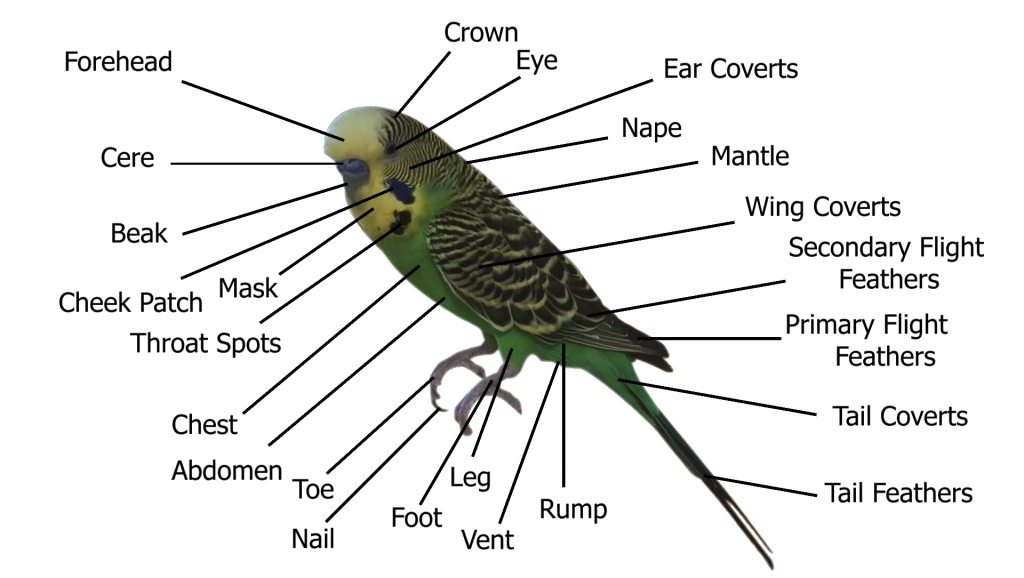Typography means the style and appearance.
Have a look at the image for reference

Click on the Feature to directly go there: Beak Nostrils Cere Mask Cheek Patches Throat Spots Eyes Forehead Crown Ear coverts Chest/Breast Abdomen Nape Mantle Wings Coverts Flight Feathers Leg Foot Nails Vent Tail Coverts Tail Feathers
Beak:
It is important to note that beaks are covered with skin.
Although cuttlebone and natural branches are usually enough for your bird to trim its beak, but if it grows longer than normal, it might be due to disease, and you should consult your avian vet.
The keratin that is produced by the bird’s beak dries and condenses to make it hard and durable.
The beak is made of two parts.
- Upper mandible: It is the part of the beak that you can see, and it is the part that your parakeet is able to move.
- Lower mandible: The hidden part which parakeets can’t move.
Because of keratin, the beak has blood vessels and nerves which makes it sensitive.
Nostrils:
They are the 2 visible holes in the cere, and if they are not clean, your bird might be sick and need a medical attention.
Cere:
It is the area above the beak surounding the nostrils and made of tough skin,
the color and smoothness of the cere depends on the budgie’s age, gender and mutation.
Mask:
It is the budgie’s face below the beak. it is either white or yellow.
Cheek patches:
The cheek patches are the triangle shaped patches of violet, grey or silver feathers below the eye on the cheek.
These are important factor for budgies to show their beauty, and attract mates.
Throat Spots:
The round (usually black) spots at the base of the mask.
Eyes:
Budgies eyes have a pupil (dark circle) and an iris (white ring around the pupil).
However, some varieties like inos don’t have a dark pupil, and some other varieties like recessive pied don’t have an iris.
Forehead:
It is the area above the cere, and it is one of the main feature you can tell, if your budgie is below 4 months or not.
and the reason behind that is because young budgies have bars on their forehead but at around 4 months they lose these bars in their first molt.
Crown:
You can see the bars in adult budgies, only on the crown which is the area that follows the forehead.
young budgies will have their bars extend further to cover the forehead as well.
Ear Coverts:
The feathers that cover the budgies ear.
Chest/ Breast:
The upper front part of your budgie.
Abdomen:
The Lower front part of your budgie.
Both the chest and abdomen can be white, yellow, green, blue ,grey, violet or any mixture of these together depending on your budgie’s variety.
Nape:
It is the back of the neck, between the crown and the mantle.
Mantle:
It is the area of feathers in a triangle between the top of the budgies wings.
Wings Coverts:
The feathers covering the wings.
Primary, secondary and tertiary flight feathers:
The feather assisting in flight, the primary feathers are the ones you clip if you want to prevent your budgie from flying.
Leg:
The skin covered part that extends from the budgie’s body to its foot.
Foot:
In budgies it has 2 fingers pointing forward and 2 fingers pointing backward.
Nails:
Located at the end of each toe , and one of the reason we keep advising people to have multiple perches of different thickness to keep your budgie’s nails trimmed.
Vent:
Basically it is the budgie’s bottom, also called cloaca.
It is a single whole that expels all waste, and for mating and egg laying.
Tail Coverts:
These are the shorter feathers at the base of the tail.
Tail Feathers:
Primary, secondary and tertiary tail feathers.
These feathers assist in flight and balance.

thank u
this app is so amazing and has helped me make a lot of decisions about my budgie